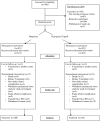A randomized controlled trial comparing mupirocin and polysporin triple ointments in peritoneal dialysis patients: the MP3 Study
- PMID: 22134627
- PMCID: PMC3280035
- DOI: 10.2215/CJN.07970811
A randomized controlled trial comparing mupirocin and polysporin triple ointments in peritoneal dialysis patients: the MP3 Study
Abstract
Background and objectives: Infectious complications remain a significant cause of peritoneal dialysis (PD) technique failure. Topical ointments seem to reduce peritonitis; however, concerns over resistance have led to a quest for alternative agents. This study examined the effectiveness of applying topical Polysporin Triple ointment (P(3)) against mupirocin in a multi-centered, double-blind, randomized controlled trial.
Design, setting, participants, & measurements: PD patients routinely applied either P(3) or mupirocin ointment to their exit site. Patients were followed for 18 months or until death or catheter removal. The primary study outcome was a composite endpoint of exit-site infection (ESI), tunnel infection, or peritonitis.
Results: Seventy-five of 201 randomized patients experienced a primary outcome event (51 peritonitis episodes, 24 ESIs). No difference was seen in the time to first event for P(3) (13.2 months; 95% confidence interval, 11.9-14.5) and mupirocin (14.0 months; 95% confidence interval, 12.7-15.4) (P=0.41). Twice as many patients reported redness at the exit site in the P(3) group (14 versus 6, P=0.10). Over the complete study period, a higher rate per year of fungal ESIs was seen in patients using P(3) (0.07 versus 0.01; P=0.02) with a corresponding increase in fungal peritonitis (0.04 versus 0.00, respectively; P<0.05).
Conclusions: This study shows that P(3) is not superior to mupirocin in the prophylaxis of PD-related infections. Colonization of the exit site with fungal organisms is of concern and warrants further study. As such, the use of P(3) over mupirocin is not advocated in the prophylaxis of PD-related infections.
Figures
References
-
- Mujais S: Microbiology and outcomes of peritonitis in North America. Kidney Int Suppl 103: S55–S62, 2006 - PubMed
-
- Johnson DW, Dent H, Hawley CM, McDonald SP, Rosman JB, Brown FG, Bannister KM, Wiggins KJ: Associations of dialysis modality and infectious mortality in incident dialysis patients in Australia and New Zealand. Am J Kidney Dis 53: 290–297, 2009 - PubMed
-
- Li PK, Szeto CC, Piraino B, Bernardini J, Figueiredo AE, Gupta A, Johnson DW, Kuijper EJ, Lye WC, Salzer W, Schaefer F, Struijk DG: Peritoneal dialysis-related infections recommendations: 2010 update. Perit Dial Int 30: 393–423, 2010 - PubMed
-
- Al-Hilali NA, Ninan VT, Al-Humoud HA, Nampoory MR, Johny KV: Mupirocin once weekly reduces the incidence of catheter exit-site infection in peritoneal dialysis patients. Perit Dial Int 25: 91–92, 2005 - PubMed
-
- Aykut S, Caner C, Ozkan G, Ali C, Tugba A, Zeynep G, Taner C: Mupirocin application at the exit site in peritoneal dialysis patients: Five years of experience. Ren Fail 32: 356–361, 2010 - PubMed
Publication types
MeSH terms
Substances
LinkOut - more resources
Full Text Sources
Medical
Research Materials



